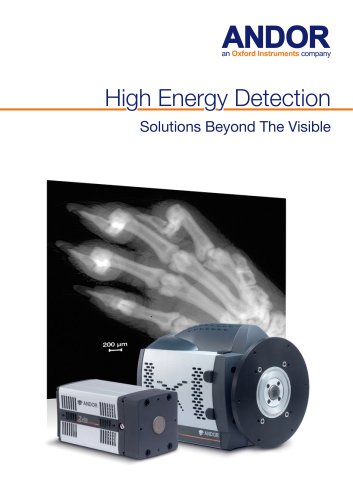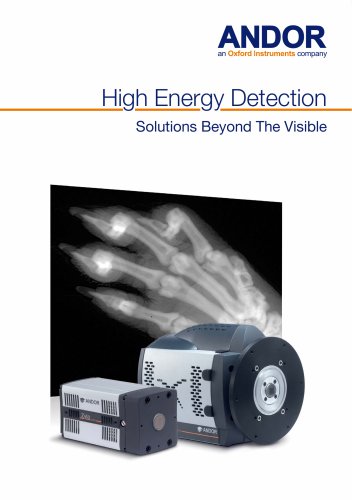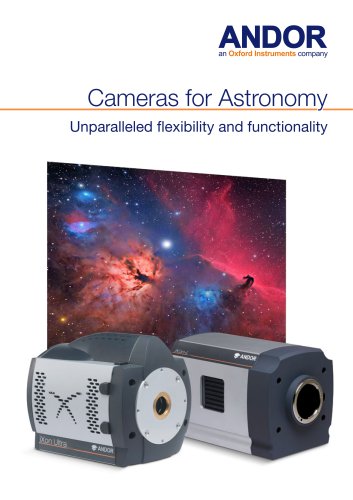
Catalog excerpts

Technical Note External Use! 5-May-06 Minimizing Darkcurrent and Clock Induced Charge in EMCCDs for Photon Counting Performance Since EMCCD technology effectively overcomes readout noise, the remaining instrumental detection limit is set by background electrons that are amplified by the EM gain register. These events are generally manifest as single pixel spikes, amplified clear of the baseline, and are derived from two sources: Darkcurrent and Clock Induced Charge (CIC), the latter sometimes known as Spurious Noise. In EMCCD’s we must pay particular care to virtually eliminate darkcurrent contribution – now that single thermally generated electrons will be amplified above the read noise floor! It is no longer sufficient to apply only enough cooling such that darkcurrent is buried in the read noise (as is historically the case in non-EMCCDs). Clock Induced Charge In order to keep CIC to a minimum, clock voltages need to be carefully controlled. Andor’s extensive experience in EM technology has resulted in the lowest CIC on the market! A detector that has not minimized EACH of these noise sources will NOT be able to successfully discriminate photon events from dark background events. The iXon+ DU-897-BV is the only camera on the market capable of true photon counting. Technical Note In fact, we have included a specification on the iXon+ spec sheet that reflects the extraordinarily low darkcurrent and CIC levels achieved – EMCCD Amplified Background Events – and is quoted alongside the traditional measurement of darkcurrent (listed still for historical reasons, but they cannot be used to extrapolate to short exposure times). For example, the iXon+ DU-897-BV yields a typical EMCCD-Amplified Background Events figure of 0.005 electrons/pixel for a 30 ms exposure @ -85oC, EM Gain x1000. We confidently challenge other camera manufacturers to match this specification!
Open the catalog to page 1
There is misunderstanding and misinformation in the market place about the required cooling for optimum operation of EMCCDs. In particular the claim that “ –30oC is sufficient cooling because Spurious Charge (also known as Clock Induced Charge, CIC) increases with cooling”. THIS IS SIMPLY NOT THE CASE! Experimental Verification The Physics does get involved but you can sidestep it by doing a simple test, the results of which are shown below. Figure 1 (over) shows three dark images taken with a Back Illuminated CCD97 chip (from E2V) at –90oC, –50oC and – 30oC, all are in frame transfer mode...
Open the catalog to page 2
Figure 1: Three dark images at varying temperatures Figure 2: Three traces at varying temperatures Notes: all images were taken with a Back Illuminated CCD97 chip at –90oC, –50oC and –30oC, all are in FT mode at maximum frame rate (34.5 frames per second, i.e. around 29 ms exposure) and an EM gain (Electron Multiplication gain) of X1000. Technical Note
Open the catalog to page 3All Andor Technology catalogs and technical brochures
-
Marana sCMOS
9 Pages
-
MicroPoint 4
9 Pages
-
ZL41 Cell sCMOS
7 Pages
-
Sona sCMOS
9 Pages
-
Optistat
11 Pages
-
Multi-Wavelength Imaging
11 Pages
-
BC43
13 Pages
-
andor-kymera-193-specifications
15 Pages
-
andor-dragonfly-specifications
14 Pages
-
Solis-Brochure
6 Pages
-
Spectroscopy-Solutions-Brochure
24 Pages
-
iKon-M/L SO Series
10 Pages
-
iStar CCD and sCMOS
8 Pages
-
Neo 5.5 sCMOS
6 Pages
-
Mechelle 5000
5 Pages
-
Cameras for Astronomy
8 Pages
-
Microspectroscopy Gatefold
8 Pages
-
Spectroscopy Brochure
25 Pages
-
Apogee Alta F9000
5 Pages
-
Apogee Aspen CG230
5 Pages
-
Apogee Aspen CG47
5 Pages
-
Apogee Aspen CG6
5 Pages
-
ApogeeAspen CG9000
5 Pages
-
iXon EMCCD
13 Pages
-
Zyla for Physical Sciences sCMOS
12 Pages
-
iVac OEM 2
2 Pages
-
iKon-M OEM 2-page PV
2 Pages
-
iKon-M X-Ray 2
2 Pages
-
Newton EMCCD
16 Pages
-
iQ Software
12 Pages
-
sCMOS
16 Pages
-
Luca vs Interline CCD
6 Pages
-
Low Light Imaging
8 Pages
-
iXon Back-illuminated
6 Pages
-
Revolution
23 Pages
-
High Energy Detection_2014
28 Pages
-
Clara Flyer
2 Pages
-
PRODUCT PORTFOLIO 2013
51 Pages
-
Andor Revolution XD brochure
23 Pages
-
Revolution DSD
11 Pages
-
Active Illumination Solutions
25 Pages
-
Clara Interline CCD Series
2 Pages
-
Intensified Camera Series
9 Pages
-
Neo and Zyla sCMOS
27 Pages
-
iXon
33 Pages
Archived catalogs
-
High Energy Detection_2019
8 Pages
-
Astronomy Brochure_2014
19 Pages
-
Astronomy Brochure
19 Pages
-
iKon-M USB X-Ray Brochure
2 Pages

























































